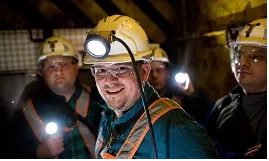Copper production requires water. For example, water is used during the ore enrichment process (flotation) and the hydro-transport of waste, as well as during the smelting process. The largest amounts are needed for the flotation process, which involves rinsing the ore from the rock mass - about 4-5 m3/t. Total water consumption by the Polish subsidiaries of KGHM alone exceeds 20 million cubic meters – clearly, water is a very precious natural resource for the company.
KGHM does its best not to impact the quality and the amount of local water resources by its operations. In Poland, the water used for the flotation process is mainly mine drainage. This water circulates in a closed circuit between the Concentrating Plants and the Żelazny Most tailings pond. At each of its facilities, the company has introduced technologically advanced wastewater treatment processes. The company also makes sure that the water coming from the production process does not penetrate surface water or contaminate ground water. The Carlota mine, in the USA, operates without any water discharge from the production process. Rare plant species, found on the territory of mines, are specially protected.
Systems for rain water collection and retention have been developed for all necessary areas. Depending on the possibilities and the location of individual facilities, rain water is channelled to storm drain systems in the nearby towns - the company offers its support when investing in the modernisation of such systems.
Importantly, recycling activities are very much supported - if possible, we try to use, for production purposes, water coming from our wastewater treatment plants or from the mines' drainage processes.
Some mines owned by KGHM are located in areas where water is an extremely precious resource, such as in the Atacama desert in Chile, which is one of the driest places in the world, or in the semi-desert in Arizona in the USA, where the annual rain fall is less than 25 cm.
The company's role in such places is not only to pay particular attention to the existing natural resources of water, but also to prevent its depletion. In the case of the Sierra Gorda project, the company decided to apply an innovative and technically ambitious environmental protection solution: the use of sea water for production. The water is obtained from the cooling system of a power plant located in the vicinity of the town of Mejillones. Before implementation of this solution, the water had been discharged back to the ocean. Now, it is pumped through a 142.6 km pipeline and stored in a retention reservoir.
During the Sierra Gorda mine’s first stage of operation, 92 million cubic meters of water will be used annually. At the same time, the company monitors identified natural springs of water and examines any possible contamination or drops in their levels.
Facilities with particularly limited water resources reuse water from wastewater treatment plants for road or landfill dampening to prevent dust from becoming airborne.






